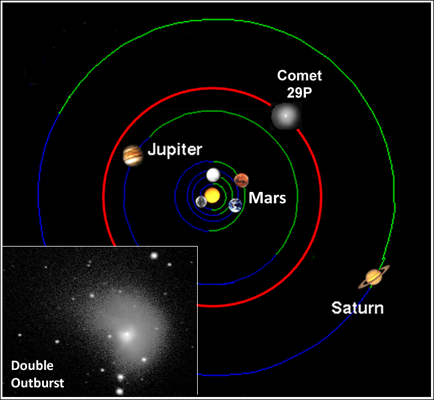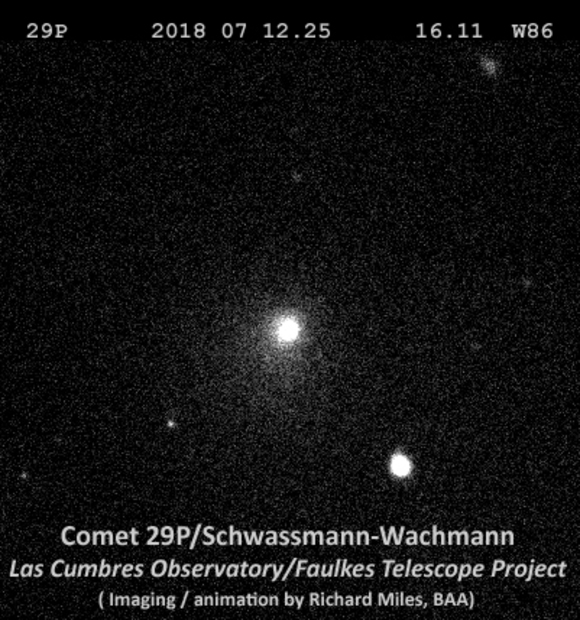MISSION 29P
- Mission 29P: Centaur Comet Observing Campaign News
- History of the Mission 29P Campaign
- Latest Data and Lightcurve Plot of 29P
- MISSION 29P and JWST data analysis
- Weak vs. Strong Outbursts and Seasonal Changes in the intensity of 29P’s outbursts (2014-2025)
What is Comet 29P?
This comet (aka 29P/Schwassmann-Wachmann 1 or 29P/SW1) was discovered in 1927 whilst exhibiting a strong outburst in brightness. These outbursts are the result of sudden eruptions at the surface of the nucleus, which measures about 60 km across. They typically happen 20-30 times each year. Prior to 2014 observers failed to detect the weak ‘mini-outbursts’ that outnumber strong outbursts with amplitudes of >1 magnitude. About 60% of all outbursts are mini-outbursts. Thanks to the dedicated observers in MISSION 29P, we have followed several outbursts (weak and strong) develop from quiescence to maximum light, and in each case the rise in brightness attains within 0.05 mag of maximum 2-3 hours after the start. N.B. The Wikipedia article about this object is very brief – much more can be found amongst these pages maintained as part of the BAA’s Comet Section.
We still do not understand what mechanism underlies its behaviour despite the fact it is readily observable every year for about 80% of the time. It would make a fascinating target for a space mission but although these have been proposed, none are currently planned. So instead of a space mission, the BAA Comet Section has launched this special project to ensure that our understanding of it is greatly improved and that our new findings will help to attract the attention of the astronomical community making it a worthy destination for a future space probe.
On 2023 February 20, the James Webb Space Telescope observed 29P for the first time and MISSION 29P obtained 2.0-m images within a few hours of the JWST epoch. We have created a webpage that contains the results of an analysis of our data and those obtained by JWST to better understand this bizarre small solar system body.

Other aspects of 29P
This mysterious object is temporarily locked in its present near-circular orbit by the gravity of the giant planets, Jupiter and Saturn. Located at a mean heliocentric distance of 6.0 au, 29P describes an orbit around the Sun every 14.7 years or so, with a perihelion distance of 5.7 au and aphelion of 6.3 au. Because it never approaches the Sun closely, it never exhibits a distinctive tail, i.e. quite unlike most people’s idea of a comet. But like Jupiter and Saturn, the comet is observable during most of each year apart from the couple of months it spends in solar conjunction. Its current location is shown in the JPL Small-Body Database Browser.
A YouTube video of a BAA Webinar on the subject of this most unusual solar system object has been available since 2021 May 14. It features Prof Laura Woodney of California State University, San Bernardino and myself presenting some latest findings about this object and talking about possibilities of sending a space probe to investigate further.
Intensive observations have been underway since 2014 when the mini-outburst phenomenon was discovered, i.e. weak outbursts not exceeeding 1.0 mag in amplitude. The following set of plots show its behaviour during its seven 2014-2020 apparitions (click on the image to obtain larger views).
So what can you do as an observer?
We have created an online group, 29P-ml, entitled Focus on Centaur comet 29P/Schwassmann-Wachmann 1 that aims to bring together observers across the world to monitor and study its nature. 29P-ml has been created as part of the BAA’s MISSION 29P initiative and to be effective, we need as many active observers as possible to keep track of it on a 24/7 basis. There are several ways you can participate: the simplest is to take images and make the FITS files available for photometric analysis by others. If you can post the images within say a day of their capture that will enable us to identify any changes that have happened recently so that others can be alerted. If you wish, you can perform the analysis yourself and send the results to the co-ordinator. Currently Richard Miles coordinates the observing campaign. Please direct any queries to him. We have a standard way of measuring the brightness of the Centaur comet, which is explained in this Observing Tutorial.
The main objectives of MISSION 29P are:
1. To detect any new outburst as soon as possible after it has taken place so that we can (a) determine the time of the event, and (b) initiate ‘target of opportunity’ images with the 2.0-m Faulkes Telescopes to study the resulting expanding coma.
2. Try to capture 29P in the process of outbursting, i.e. observations start just before an eruption happens then measuring the brightness increase of the inner coma, determine maximum brightness, and then follow its subsequent decline photometrically. The rise and fall tells us about the underlying processes going on on this strange body.
3. Establish a long-term archive of: (a) its photometric lightcurve (intensive observations began in 2014); (b) a high-precision astrometry archive (so its orbit is precisely known for the prediction of stellar occultations); and (c) archive images depicting the development of the expanding coma after each significant outburst. Access to the 2.0-m Faulkes Telescopes in Hawaii and Australia is transforming our understanding. It has been possible to study the properties of the nucleus alone by extrapolating the coma profile to zero photometric aperture size using the 2.0-m images. Help from members with analysing these 2.0-m images would be very welcome.
4. Observers equipped to observe and accurately time stellar occultations may be interested in recent developments which are permitting us to measure the size and shape of the ~60-km nucleus.
Website development
There is a wealth of observations available via MISSION 29P. It is hoped that most of this information can be documented through this portal not only by recording past observations, but also highlighting new findings that help our understanding of this object.
Here is a summary of the layout envisaged, which gives a good idea of the content that is potentially available as of 2024 Nov 22:
—————————————————-
Outburst compilation
Below is a video made from a series of some 57 images taken with 1.0-m telescopes of the Las Cumbres Observatory network over a two-month period showing an outburst that began on 2018 August 01 and which brightened from magnitude 16.5R to reach magnitude 14.2R within just a few hours. The field of view is about 2 arcminutes square. If necessary, to see the animated video clip, right click on the image and select ‘Open image in new tab’ then open the new tab.

| The British Astronomical Association supports amateur astronomers around the UK and the rest of the world. Find out more about the BAA or join us. |

